Full of Charm – Chinese Jade Toggles
PRIMITIVE - Wednesday, December 23, 2015By Misaki Imagawa
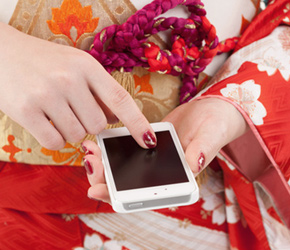 |
|
Although most Japanese no longer wear traditional kimonos, I come from a tradition-loving family and when growing up frequently wore them for special occasions such as family gatherings and dinner parties. My most elaborate kimono was reserved for New Year's Day. It had full length sleeves reaching down past my knees and a sash that took nearly thirty minutes to knot. Altogether, this kimono took over an hour to put on with the help of two extra people; but the beautiful outcome was always worth the effort.
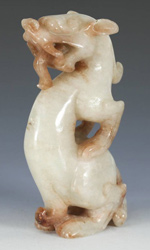 |
|
|
|
Yet, I still consider myself a modern person. The one major problem I had with my Kimono was the lack of a pocket to stash my phone. I tried sticking it in my sash, but it ruined the overall look of the kimono. I also tried holding it discreetly in my hands, but that made no sense because I needed both of them to serve ceremonial rice wine. After some research I learned people in old Japan had similar issues. Although they didn't have phones, they needed to carry pipes, medicines, perfumes, coins, and other small personal items. They stored these articles in little pouches with long drawstrings that had a small counterweight attached at their ends. The counterweight was called a netsuke and it enabled the drawstrings to be looped around the kimono sash more securely. Today, netsukes are sought after collectibles; yet, they originated with Chinese toggles.
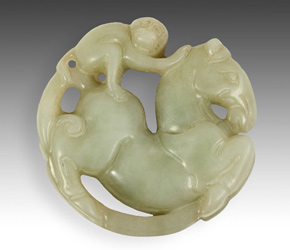 |
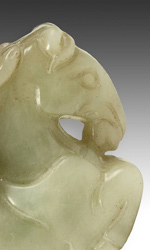 |
|
Much like Japanese kimonos, traditional Chinese attire had no pockets too. People of all social classes, from rickshaw drivers to court scholars used toggles as counterweights to help secure small bags on their sashes. Though toggles were made of various materials, the most preferred and valued was jade, a precious stone that has been an integral part of Chinese culture since the Neolithic Period (9500 - 9000 BCE). A famous quote attributed to Confucius describes jade in this way: "Soft, smooth and glossy – it appeared to them like benevolence; fine, compact and strong – like intelligence; angular, but not sharp and cutting – like righteousness." It represented purity, beauty and immortality, and was cherished over all else, even gold. It was called the 'stone of heaven.'
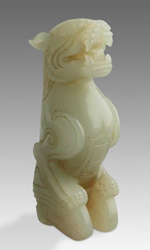 |
|
One of the most beautiful aspects of Chinese jade toggles is their symbolism, which was carved into each miniature sculpture. Most often toggles depicted auspicious symbols, making them ideal to be given as gifts or carried as good luck charms. For example, monkey and lion motifs were popular. The monkey symbolized health, success and protection; the lion valor, energy and mastery. As a result, these toggles came to symbolize high government rank. The meaning of symbols could also be found in a play on words. For instance, the Chinese word for monkey, hou, can sound just like the Chinese word for Marquis. The word for lion, shi,can sound just like the words for tutor and thoughts. Consequently, these types of toggles were also given to young men who desired success and lucrative positions. To this end, the carp, or liyu, was also a powerful symbol. In nature, the carp jumps up small waterfalls, and traditional legends say by accomplishing this feat they could transform into dragons. Jade liyu were often given to a young man passing his civil service examinations, transforming him from a small fish to a mighty dragon.
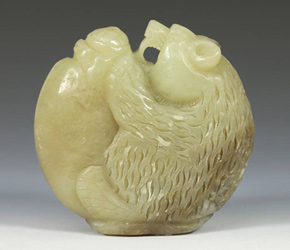 |
|
The dragon itself is also a widely used and popular motif on Chinese toggles, for it symbolizes wisdom, knowledge, ambition, prosperity, rain and fertility. The dragon was also considered the highest class of animated nature and in Chinese mythology had the capacity to become invisible, thus making it a sort of stealth protector. The dragon was such an important motif that slight variations in its depiction could signal additional meanings. For example, a dragon with five claws represented the emperor and imperial authority. The phoenix – the yin to the dragon's yang – was the traditional image of the empress. When the dragon and phoenix were joined they symbolized the union of man and woman. As a result, toggles featuring the two mythical creatures were often given as wedding gifts along with well-wishes of marital bliss.
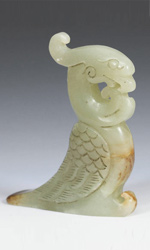 |
|
Abundance and wealth are represented by a variety of jade toggle motifs. Some of you may already be familiar with the three-legged toad with a coin in its mouth called Jin Chan, also known as Chan Chu, the money toad, the golden toad, and the money frog. Chan Chu is the most popular motif on charms and toggles meant to bring prosperity. Chan Chu is said to appear near individuals, houses and businesses that will soon receive good news. In Chinese mythology the coin is the symbol of abundance, wealth, and regeneration, so it is completely appropriate that this magical charm holds one in its mouth. Chan Chu not only attracts and protects wealth, but guards against bad luck. Of all the symbols in Chinese mythology, the money frog is considered to be the most potent when it comes to the creation of wealth, prosperity, and abundance; but other symbols can mean the same thing and are also popular toggle motifs. The rat also represents wealth. In addition to finishing first in the zodiac race through its cunning nature and intelligence, rats tend to hoard food, which is perfect for symbolizing abundance. The fish is another popular motif illustrating wealth, as yu is the term for both 'fish' and 'affluence.'
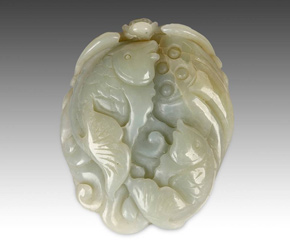 |
|
Toggles meant to attract good fortune and blessings were also popular. Many depicted a bat motif because the word for bat – fu – and good fortune can appear and sound the same. In particular, an upside down bat meant that 'happiness had arrived.' Also interesting is a type of citron fruit that looks like dangling fingers. It is known as the ‘Hand of Buddha,’ and is called fushou in Chinese: fu for good fortune and shou for longevity. A toggle carved with this imagery was appropriate as a gift for a respected grandparent. In return, an elder would present a younger relative with a toggle depicting an adult animal with its young; such imagery representing family continuity for generations. Two other motifs also represented good fortune and blessings – the eagle and the bear. Young men entering the military were often given a toggle depicting these creatures, pronounced ying and xiong respectively, because yingxiong is the term for 'hero'.
In Chinese art there is no lack of symbolism; and nothing exemplifies this idea more than jade toggles, where nothing is devoid of significance. From legends to puns to a vast array of animal, plant and mythological symbols, jade toggles were often considered potent, magical charms. In essence, they were attractants meant to be a magnet for whatever they symbolized. Originally worn for utilitarian purposes, in old China they became valuable gifts and prized artworks; and today, they have become valuable collectibles, sometimes fetching enormous prices. The examples described here only scratch the surface of a much broader range of meaningful imagery and motifs used in jade carvings. Language was often the source of this imagery; so here’s a piece of ironic trivia. The Japanese word for 'mobile phone' is keitai denwa. 'Keitai' is derived from two characters that mean 'something small to hang from a sash' – exactly what Chinese toggles and Japanese netsukes were designed to do. Yet, when I wear my kimono there is still nowhere to put my phone!
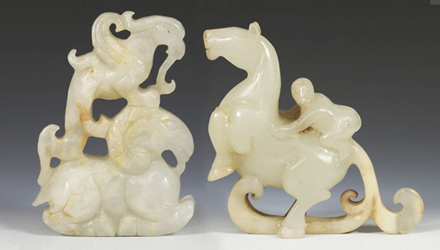 |
Download this Article: Full of Charm - Chinese Jade Toggles.pdf